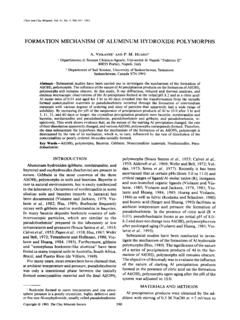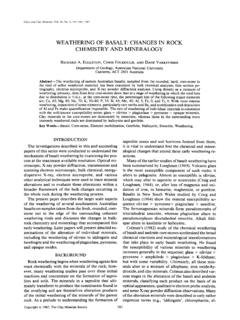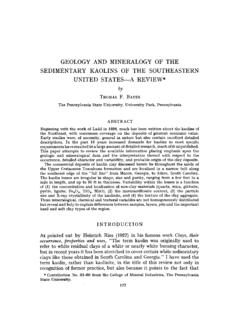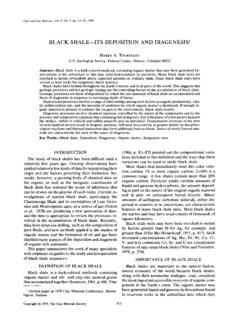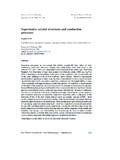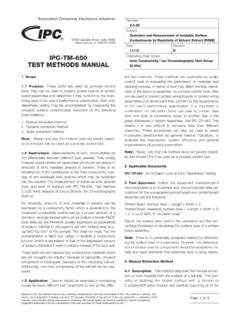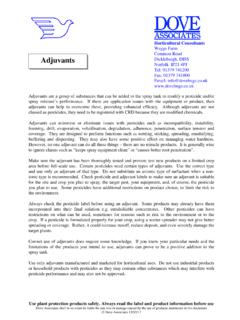Transcription of DLVO AND NON-DLVO INTERACTIONS IN …
1 Clays and Clay Minerals, VoI. 38, No. 2, 151-159, 1990. DLVO AND NON-DLVO INTERACTIONS IN HECTORITE C. J. VAN OSS, 1 R. F. GIESE, 2 AND P. M. COSTANZO 2 1 Departments of Microbiology and Chemical Engineering, State University of New York at Buffalo, 3435 Main Street, Buffalo, New York 14214 2 Department of Geology, State University of New York at Buffalo, 4240 Ridge Lea Road, Amherst, New York 14226 Abstract--The Derjaguin-Landau-Verwey-Overbeek (DLVO) theory sums the attractive van der Waals and repulsive electrostatic forces as a function of separation distance to predict the interaction between charged particles immersed in a liquid. In aqueous media, however, non-electrostatic polar (electron acceptor/electron donor or Lewis acid/base) forces between particles with high energy surfaces often are comparable to, or greater than, the components of DLVO theory. By means of contact angle measurements on smooth self-supporting clay films, the values of the polar surface forces (AB) and the van der Waals forces (LW) of hectorite were measured.
2 Determinations of ~" were used to derive the electrostatic forces (EL). Calculations based on the values obtained for the EL, LW, and AB forces show that for smooth spheres with a radius of 1 t~m in a -> M NaC1 solution a net attraction exists leading to flocculation. At NaCI concentrations of -< M, a repulsion energy of about +500 to + 1300 kT exists at separation distances -< 50 A,, preventing contact between particles, thus ensuring stability of the colloidal suspension. At these concentrations, theory predicts that small clay particles or edges of clay crystals having an effective radius of curvature < 10 A should be energetic enough to overcome the repulsion barrier which prevents flocculation. Experimentally, for NaC1 solution concentrations of -> M, suspensions of hec- torite particles flocculated, whereas at concentrations of -> M, the suspensions remained stable. These experimental results agree with the predictions made by summing all three forces, but contradict the calculations based on classical DLVO theory.
3 Key Words--Colloid, Contact angle, DLVO theory, Electrostatic forces, Hectorite, Polar forces. INTRODUCTION The forces between colloidal particles of clay min- erals in aqueous suspensions are of great importance to many geological and industrial processes. For ex- ample, the rheologic properties of phyllosilicate min- erals, neglecting impurities, are controlled by the rel- ative magnitudes of their surface energy components. Until recently, these forces have been described in the context of the classical DLVO theory, named after its originators Derjaguin and Landau (194 I) and Verwey and Overbeek (1948). This model, however, takes into consideration only the electrostatic (EL) and the Lif- shitz-van der Waals electrodynamic (LW) forces; it does not take into account the polar forces that are often the dominant forces between particles in polar media (van Oss et al., 1987a, 1987b, 1988a). For some time, the presence of physical forces in colloidal systems other than the EL and LW was sur- mised, particularly for the interaction energies of par- ticles separated by short distances (-<50 ~).
4 For ex- ample, Israelachvili and McGuiggan (1988), in their review of forces between surfaces in liquids, discussed several systems in which the presence of unaccountable attractive and repulsive forces were observed. They suggested that these deviations from classical DLVO theory were due to the existence of additional forces rather than to a complete breakdown in the DLVO theory. For clay particle INTERACTIONS in particular, the Copyright 9 1990, The Clay Minerals Society additional repulsive forces could, in part, be attributed to hydration forces, but the origin of these forces was not clear. Low (1987) also concluded that at small in- tel-particle distances an additional interaction force, which he ascribed to the hydration of the (001) surfaces, must be taken into account. The additional forces, as mentioned above, are often referred to as "hydrophobic INTERACTIONS " if particle- particle attraction exists, and as "hydration pressure" if particle-particle repulsion exists.
5 The origin of these forces lies in electron acceptor-electron donor inter- actions (in the Lewis acid-base sense). The term polar (AB) forces is used to refer to all such INTERACTIONS (van Oss et al., 1987a, 1987b, 1988a, 1988c). The AB forces (which include hydrogen bonding), if strongly asym- metrical or monopolar, are responsible for the orien- tation of water molecules adsorbed on the surfaces of a clay mineral, and, as expected, water molecules ori- ented on the surface of one panicle will repel water molecules oriented in the same manner on the surface of an adjacent particle (Parsegian et aL, 1985). If the orientation of the water molecules by the surface of the clay mineral is sufficiently strong, the two particles will not be able to approach each other, or, if particles are close together, they will be forced apart as additional oriented water molecules are adsorbed on the two sur- faces. On the other hand, if the clay mineral's surface is more weakly monopolar, its capacity for orienting the most closely adsorbed water molecules is less pro- 151 152 Oss, Giese, and Costanzo Clays and Clay Minerals nounced, and the clay particles will approach each oth- er under the influence of their net van der Waals (LW) attraction.
6 Thus, the "solvation" (or "hydration") ef- fects are, in the final analysis, caused by the orientation of adsorbed water molecules due to the monopolar AB forces, and these "hydration" effects are, in their turn, responsible for the medium-range to long-range influ- ence of the underlying AB forces. Thus, the AB forces are capable of explaining the phenomena generally de- scribed as "solvation" effects. These solvation effects also explain why AB INTERACTIONS are not as short-range as might be supposed. In 1984, Chaudhury made a clear distinction be- tween the AB forces occurring in colloidal systems and all three types of LW forces (Chaudhury, 1984; van Oss et al., 1987a, 1987b, 1988a, 1988b; see also Fowkes, 1963). The omission of the AB forces, which may be one or two orders of magnitude greater than the EL and LW forces (van Oss et al., 1988a), is the origin of most of the anomalies that were observed if the DLVO theory was used to interpret interfacial INTERACTIONS in polar media (Girifalco and Good, 1957; Good and Girifalco, 1960; Fowkes, 1963).
7 The addition of AB forces to the EL and LW forces yields a new and potentially powerful theory capable of predicting many aspects of clay behavior and, par- ticularly, the behavior of colloidal clay mineral sus- pensions. The purpose of the present study is to de- scribe and explain the stability ofhectorite suspensions and to illustrate the methodology behind the mea- surement of the individual components of the forces. As a test of the predictions of the classical and extended DLVO theories, hectorite suspensions in aqueous so- lutions of different NaCl molarities were prepared. THEORY OF SURFACE ENERGY COMPONENTS DLVO theory arrives at a free energy (Gibbs energy) of interaction between particles by summing the re- pulsive EL INTERACTIONS and the attractive LW inter- actions as a function of particle separation (/) to arrive at a total free energy of interaction for a given sepa- ration. The problem is that the calculated curves of energy vs.
8 Particle separation often do not match ex- perimental results, thus putting predictive values into a rather precarious position. Classically, energy vs. distance diagrams only con- sider the sum of EL and apolar LW forces; but in polar and especially in aqueous media AB energies, whether repulsive or attractive, commonly are as much as 100 times greater than LW energies, and l0 or more times greater than EL energies at close range (10-50 ]k). Thus, in aqueous solutions, the inclusion of AB forces is not a novel and supplementary refinement of the DLVO theory, but a drastic correction, which for the first time allows aqueous INTERACTIONS to be calculated on a rea- sonably accurate scale. Electrostatic forces (EL) Repulsive electrostatic INTERACTIONS between parti- cles arise from unsatisfied electronic charges on the surfaces of the particles. In clay minerals, these charges are generally (but not always) negative and arise from structural cation substitutions.
9 Because the layer charge of clay minerals is determined by the amount and kind of cationic substitution, the surface charge density is independent of salt concentration in the suspension solution. As explained below, however, the salt con- centration is very important in the ftocculation-de- flocculation behavior of clay minerals. In terms of the chemical formula, clay crystals are electrostatically neutral, but this is not true if the clay is added to water to form a suspension. As the clay particles become dispersed in water, some oftbe charge- balancing cations are desorbed and go into solution; very quickly, an equilibrium between the desorbing and adsorbing cations is reached. This fluctuating cat- ion loss and gain means that as long as the clay is kept submersed it has a small, net negative charge. This negative charge, plus the (apparently unsatisfied) charge due to the unequal distribution of surface charge and charge-balancing cations, constitutes the electric po- tential oftbe clay particles, as manifested by their elec- trokinetic surface potential.
10 It is this surface potential that is responsible for the clay's ability to remain in suspension, seemingly forever, in a polar solvent such as water. Although, as stated above, the charge density is an inherent property of a clay crystal and cannot be changed by the presence of cations in solution, the presence of cations can decrease the effect of the charge potential. Double layer theory has been extensively used to evaluate the interaction of charged clay particles in salt solutions of various strengths. An extensive discussion of the role of double layer theory in clay colloid chem- istry was given by van Olphen (1977); see also Over- beek (1952a). Briefly, the Stern model of the double layer theory says that on the surface of a charged particle within a colloidal suspension are strongly bound counter-ions and water molecules. This static layer is referred to as either the Stern layer or the inner-Helmholtz plane. The next layer out from the particle surface and its associated Stern layer is the more diffuse outer-Helm- holtz plane containing hydrated counter-ions along with water molecules that can orient more freely.

